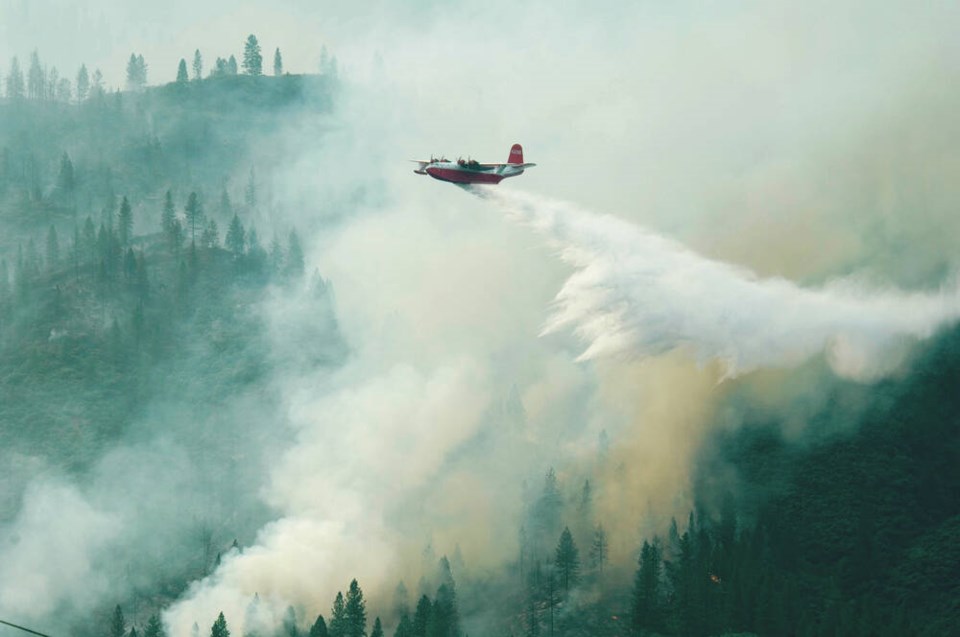The final flight of the Hawaii Martin Mars water bomber is getting a $250,000 boost from the provincial government as the iconic firefighting aircraft travels from Sproat Lake to the B.C. Aviation Museum in North Saanich.
Officials on Thursday that would see the massive aircraft operational by the end of the year so that it can be moved to the museum.
The one-time funding from the provincial government to the museum will help establish the aircraft as the centrepiece of its new B.C. wildfire aviation exhibit.
Lana Popham, minister of tourism, arts, culture and sport, called the aircraft a proud symbol of B.C.’s ingenuity and innovation, representing cutting-edge technology in aviation firefighting of its time.
“We recognize the value the Hawaii Martin Mars water bomber holds for many people and have heard their desire to have it housed in the British Columbia Aviation Museum, where it can be displayed and protected as an important piece of our province’s history,” she said at a press conference at Coulson Aviation’s air tanker base at Sproat Lake.
The water bomber, with its 200-foot wingspan, was last active fighting fires in 2015 and was operational on the Island for more than a half century, able to drop 6,000 gallons of water on fires in a single pass.
Its final flight is expected before the end of 2024 and will be a multi-phased process that includes passing federal inspections, crew training and test flights.
The Hawaii Martin Mars can land and take off only on water, so its last flight will be from Sproat Lake to the Saanich Inlet near the Victoria International Airport.
The aircraft will be brought up on a ramp at Canadian Coast Guard Base Patricia Bay, a former seaplane port, mounted on a trailer in a swivelling cradle and transported across Victoria International Airport runways.
A flight plan is expected to be heavily publicized so people along the route will be able to see the plane fly a last time.
The museum is raising funds to build a new hangar to house the Martin Mars Hawaii and other B.C. firefighting aircraft on land donated by the Victoria Airport Authority. The new exhibit will be interactive, inviting visitors to explore the features of the aircraft up close.
The Hawaii is one of only two Martin Mars water bombers left. The other, Philippine Mars, was retired in 2012 and is not considered airworthy. It remains at the Coulson air base.
Coulson Aviation will enlist five former certified maintenance engineers and four flight crew to complete about 10,000 hours of aircraft preparation and flight retraining over the next six months to prepare the red-and-white Hawaii Martin Mars for its last flight.
Wayne Coulson, CEO of the Coulson Group of companies, did not attend the press conference, but said in a statement he was pleased to partner with the museum in the “important endeavour” to preserve it.
“The Hawaii Martin Mars water bomber is an amazing aircraft,” Coulson said. “After this flight, you will probably never see one fly again.”
Steve Nichol, president of the B.C. Aviation Museum, said the project to acquire the water bomber started more than two years ago.
“I am overjoyed at the prospect of not only preserving this vintage aircraft, but to be able to showcase its fascinating history as a B.C. aviation story,” Nichol said.
The museum attracts about 20,000 visitors a year, and having the water bomber is an opportunity to raise the profile of British Columbia’s aviation history.
Richard Mosdell, the project lead in getting the bomber for the museum, said he’s been overwhelmed with the support.
“There hare so many people on the Island with Mars DNA. … They’ve worked on the planes, flown them, seen them and just love them,” Mosdell said. “They’re coming up to me and shaking my hand, saying thank you for not letting this plane leave the Island.”
Only seven Martin Mars were made by the California-based Glenn L. Martin Company, all for the U.S. Navy as ocean patrol and long-range transports during the Second World War. Most were used for naval cargo in the Pacific.
The Hawaii Martin Mars was also enlisted as the largest air ambulance during the Korean War until it was converted in 1958.
The last four planes, sold as scrap, were bought by a B.C. forestry consortium and later converted to water bombers. One Mars crashed while firefighting near Nanoose Bay in 1961, with the loss of four crew. Another was critically damaged in a storm.
The remaining two Martin Mars bombers were acquired by the Coulson Group in 2007 from Timberwest and its subsidiary, Forest Industrial Flying Tankers.

